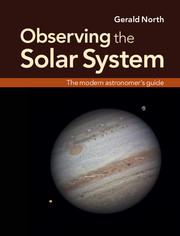Book contents
- Frontmatter
- Contents
- Preface
- Acknowledgements
- Chapter 1 Earth and sky
- Chapter 2 Moon and planet observer's hardware
- Chapter 3 The Solar System framed
- Chapter 4 Stacking up the Solar System
- Chapter 5 Our Moon
- Chapter 6 Mercury and Venus
- Chapter 7 Mars
- Chapter 8 Jupiter
- Chapter 9 Saturn, Uranus and Neptune
- Chapter 10 Small worlds
- Chapter 11 Comets
- Chapter 12 Our daytime star
- Appendix 1 Telescope collimation
- Appendix 2 Field-testing a telescope's optics
- Appendix 3 Polar alignment
- Index
- Frontmatter
- Contents
- Preface
- Acknowledgements
- Chapter 1 Earth and sky
- Chapter 2 Moon and planet observer's hardware
- Chapter 3 The Solar System framed
- Chapter 4 Stacking up the Solar System
- Chapter 5 Our Moon
- Chapter 6 Mercury and Venus
- Chapter 7 Mars
- Chapter 8 Jupiter
- Chapter 9 Saturn, Uranus and Neptune
- Chapter 10 Small worlds
- Chapter 11 Comets
- Chapter 12 Our daytime star
- Appendix 1 Telescope collimation
- Appendix 2 Field-testing a telescope's optics
- Appendix 3 Polar alignment
- Index
Summary
Our nearest neighbour in space is the celestial body that most people first look at with their newly acquired telescope or binoculars. It provides real spectacle when seen through even the lowliest of equipment and the sight of the lunar surface through a half-way decent telescope is nothing short of stunning. Add a little insight into the Moon's real nature and evolution and the spectacle becomes augmented by a level of intellectual fascination that can, believe me, persist for a lifetime.
The Moon is a rocky body with an equatorial diameter of 3476 km, over a quarter of that of the Earth. Its mass is 7.4 × 1022 kg, the Earth's mass being 81 times greater. Dividing its mass by its volume gives it a mean density of 3340 kg/m3, roughly three-fifths that of the Earth.
The brilliant light of the Moon in the night sky is almost entirely due to reflected light from the Sun, with a small amount added due to indirect sunlight reflecting off the Earth’s surface. There is also a very small contribution caused by fluorescence – the re-radiation at visible wavelengths of previously invisible solar short-wave radiations by some of the Moon’s surface minerals.
- Type
- Chapter
- Information
- Observing the Solar SystemThe Modern Astronomer's Guide, pp. 121 - 156Publisher: Cambridge University PressPrint publication year: 2012



